
The Southern Railway (SR), sometimes shortened to 'Southern', was a British railway company established in the 1923 Grouping. It linked London with the Channel ports, South West England, South coast resorts and Kent. The railway was formed by the amalgamation of several smaller railway companies, the largest of which were the London and South Western Railway (LSWR), the London, Brighton and South Coast Railway (LB&SCR) and the South Eastern and Chatham Railway (SE&CR). The construction of what was to become the Southern Railway began in 1838 with the opening of the London and Southampton Railway, which was renamed the London & South Western Railway.
The Southern Railway took a key role in expanding the 660 V DC third rail electrified network begun by the London & South Western Railway. As a result of this, and its smaller operating area, its steam locomotive stock was the smallest of the 'Big Four' companies.
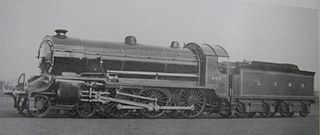
The LSWR/SR H15 class was a class of 2-cylinder 4-6-0 steam locomotives designed by Robert Urie for mixed-traffic duties on the LSWR. Further batches were constructed by Richard Maunsell for the Southern Railway after 1923. They were given the nickname of "Junior King Arthur" due to the size of their driving wheels, with those on the S15 and their N15 counterparts being 5 ft 7 in (1.70 m) and 6 ft 7 in (2.01 m) diameters respectively.
The SR N15X class or Remembrance class were a design of British 4-6-0 steam locomotives converted in 1934 by Richard Maunsell of the Southern Railway from the large LB&SCR L class 4-6-4 tank locomotives that had become redundant on the London–Brighton line following electrification. It was hoped that further service could be obtained from these locomotives on the Southern's Western Section, sharing the duties of the N15 class locomotives. The locomotives were named after famous Victorian engineers except for Remembrance, which was the LBSCR's memorial locomotive for staff members who died in the First World War.

The LSWR N15 class was a British 2–cylinder 4-6-0 express passenger steam locomotive designed by Robert Urie. The class has a complex build history spanning three sub-classes and ten years of construction from 1918 to 1927. The first batch of the class was constructed for the London and South Western Railway (LSWR), where they hauled heavy express passenger trains to the south coast ports and further west to Exeter. After the Lord Nelsons, they were the second biggest 4-6-0 passenger locomotives on the Southern Railway. They could reach speeds of up to 90 mph (145 km/h).

The SR V class, more commonly known as the Schools class, is a class of steam locomotive designed by Richard Maunsell for the Southern Railway. The class was a cut down version of his Lord Nelson class but also incorporated components from Urie and Maunsell's LSWR/SR King Arthur class. It was the last locomotive in Britain to be designed with a 4-4-0 wheel arrangement, and was the most powerful class of 4-4-0 ever produced in Europe. All 40 of the class were named after English public schools, and were designed to provide a powerful class of intermediate express passenger locomotive on semi-fast services for lines which could cope with high axle loads but some of which had short turntables.

Eastleigh Works is a locomotive, carriage and wagon building and repair facility in the town of Eastleigh, in the county of Hampshire in England.

The LSWR S15 class is a British 2-cylinder 4-6-0 freight steam locomotive designed by Robert W. Urie, based on his H15 class and N15 class locomotives. The class had a complex build history, spanning several years of construction from 1920 to 1936. The first examples were constructed for the London and South Western Railway (LSWR), where they hauled freight trains to the south coast ports and further west to Exeter, as well as occasional passenger work in conjunction with their larger-wheeled N15 class counterparts.

The London and South Western Railway L11 class was a class of 4-4-0 steam locomotives designed for mixed traffic work. They were introduced in 1903 and were nicknamed "Large Hoppers". As with most other Drummond productions, the locomotive had two inside cylinders and Stephenson link valve gear.
Robert Wallace Urie was a Scottish locomotive engineer who was the last chief mechanical engineer of the London and South Western Railway.
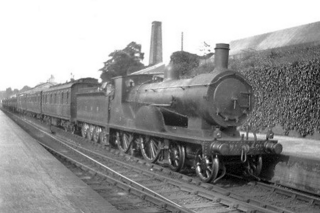
The London and South Western Railway T9 class is a class of 66 4-4-0 steam locomotive designed for express passenger work by Dugald Drummond and introduced to services on the LSWR in 1899. One example has been preserved after British Railways ownership. They were given the nickname of "Greyhounds" due to their speed, up to 85 miles per hour (137 km/h), and reliability.

The LSWR 415 class is a 4-4-2T steam tank locomotive, with the trailing wheels forming the basis of its "Radial Tank" moniker. It was designed by William Adams and introduced in 1882 for service on the London and South Western Railway (LSWR).

The LSWR T14 class was a class of ten 4-6-0 locomotives designed by Dugald Drummond for express passenger use on the London and South Western Railway and constructed at Eastleigh in 1911–12.

The LSWR G14 class was a class of 4-6-0 locomotive designed by Dugald Drummond for the London and South Western Railway.
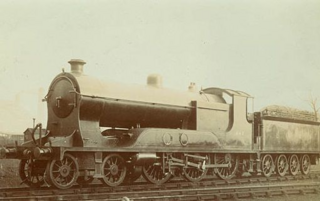
The LSWR P14 class was a class of 4-6-0 locomotive designed by Dugald Drummond for the London and South Western Railway.

The LSWR D15 class 4-4-0 was the last steam locomotive design by Dugald Drummond for the London and South Western Railway in 1912. By 1912, Dugald Drummond had built several classes of unsuccessful 4-6-0 express passenger locomotives. The result of these failures was that when he designed what was to be his last class in 1911, a new 4-4-0 design emerged from Eastleigh Works in February 1912, with what was to be the first of his D15 class.
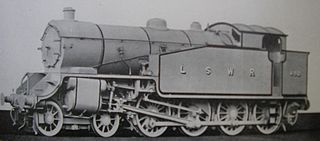
The LSWR G16 class was a class of steam tank locomotives with a 4-8-0T wheel arrangement. It was designed by Robert Urie and introduced in 1921 specifically for heavy shunting over humps at Feltham marshalling yard, on the London and South Western Railway (LSWR). They were based upon Urie's previous S15 class freight design, and apart from several periods of operating elsewhere on the LSWR and Southern railway network, they remained at Feltham for most of their operational careers.

Southern Railway 777 Sir Lamiel is an N15 "King Arthur" class 4-6-0 steam locomotive built for the Southern Railway by the North British Locomotive Company in June 1925, and withdrawn from service in October 1961. The locomotive is named after a fictional minor Knight of the Round Table named Sir Lamiel of Cardiff. Lamiel is mentioned in Book XIX of Thomas Malory's Le Morte d'Arthur, where it is said he was "a great lover". No. 30453 King Arthur was first selected for preservation, but the lack of a Drummond water cart tender led to it being scrapped, and No. 30777 Sir Lamiel was selected for preservation instead.
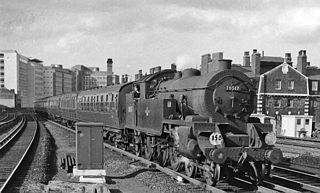
The LSWR H16 class were five 4-6-2T tank locomotives designed by Robert Urie for the London and South Western Railway (LSWR) in 1921–1922. They were the last new design for the LSWR and their only Pacific-type design.

The SECR E class was a class of 4-4-0 tender locomotives designed by Harry Wainwright for express passenger trains on the South Eastern and Chatham Railway. It was a larger version of the D class incorporating a Belpaire firebox






































